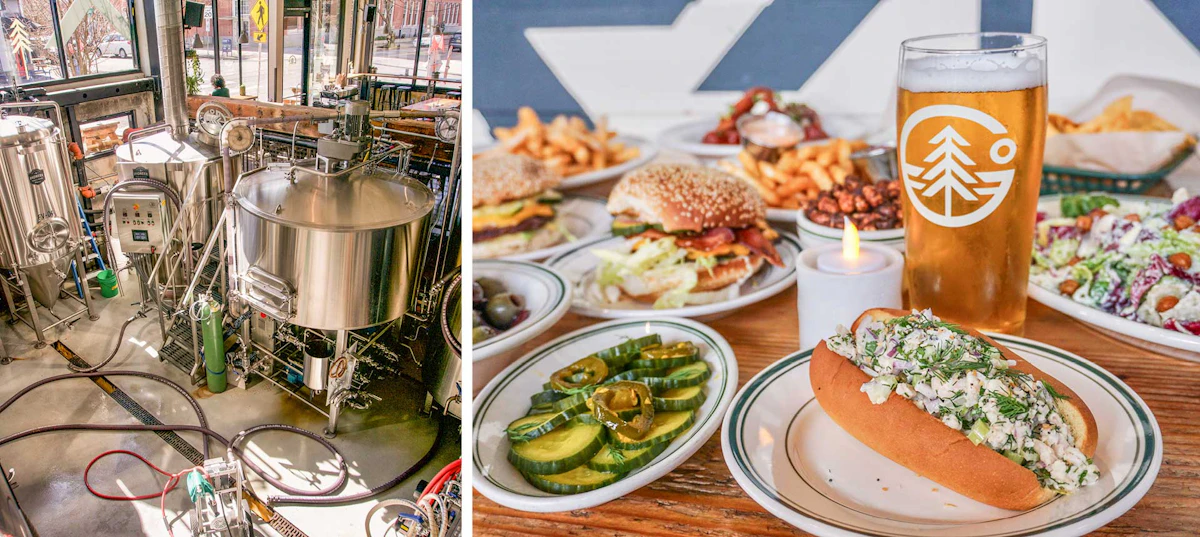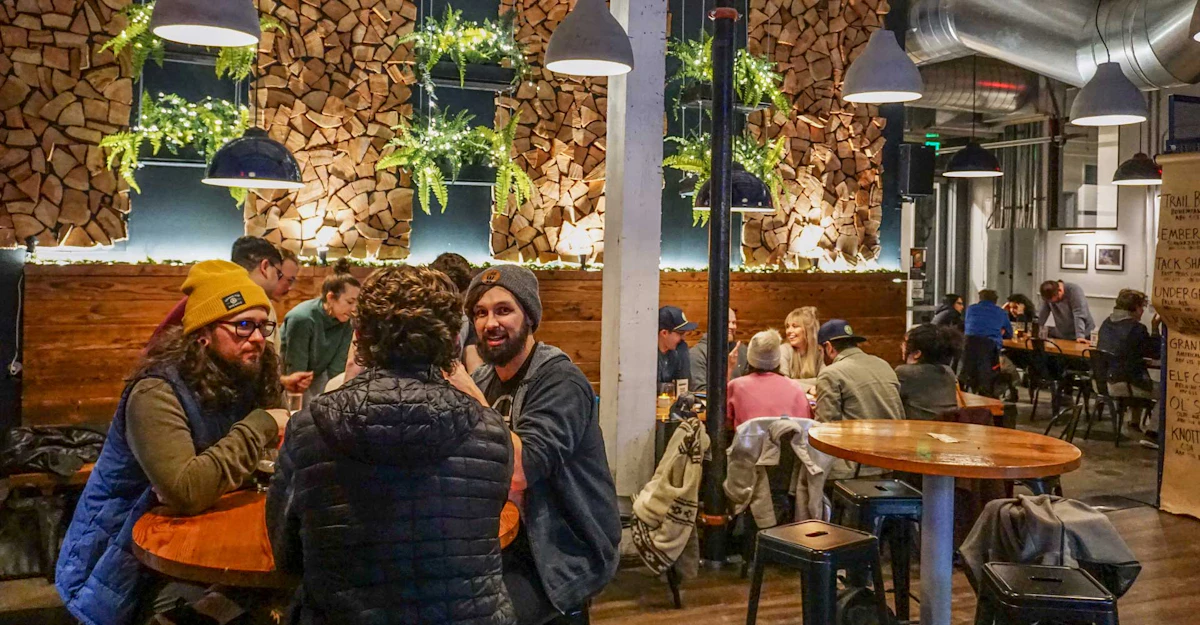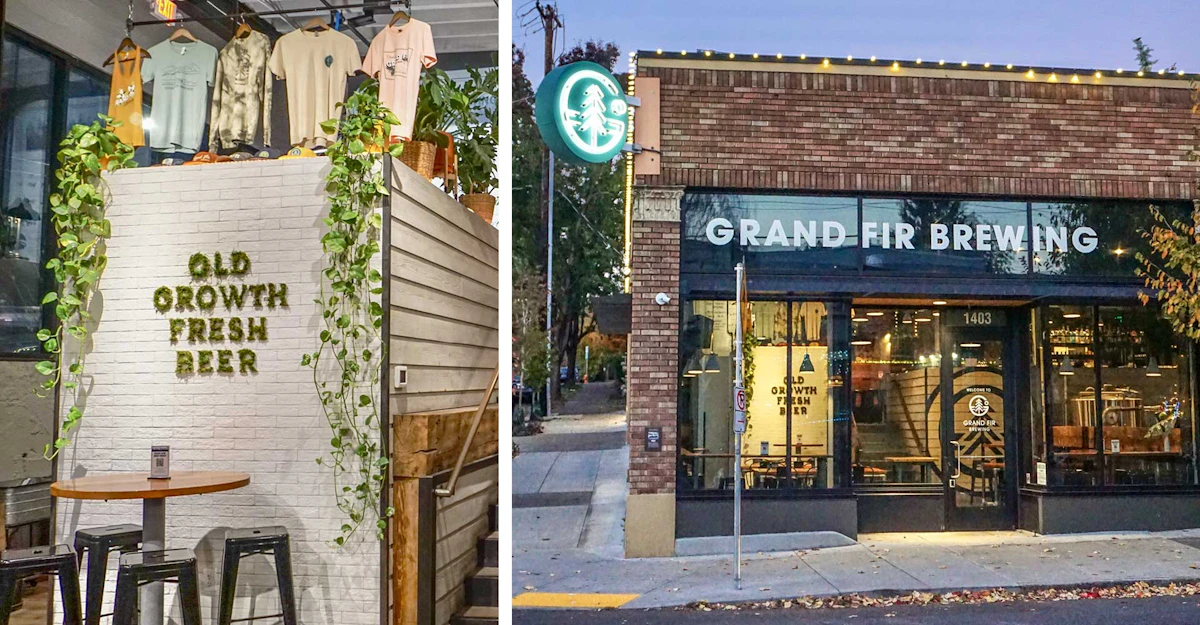Even the briefest look at Whitney Burnside’s and Doug Adams’ résumés would suggest there’s no universe in which the husband-wife duo wouldn’t open a brewpub.
Burnside is a celebrated brewer with a culinary degree and years of experience at Upright, Elysian, and Pelican; most recently, she was brewmaster at 10 Barrel’s outpost in Portland’s Pearl District. Adams is equally respected as a chef, a finalist on Bravo’s Top Chef series, and a semifinalist for the James Beard Foundation’s Rising Star Chef award. A brewpub, on paper, seems destined.
Today, however, nothing in craft beer or hospitality is guaranteed. Opening a brewpub in Portland, Oregon, in 2022 meant confronting a slowing craft-beer market, a restaurant industry still in pandemic recovery mode, and a widely reported decline in the city’s population. At home, the couple was raising a three-year-old daughter without any nearby family.
In many ways, Grand Fir Brewing would be the culmination of the couples’ careers. It was also going to require enormous effort.
Burnside and Adams have put in that effort. They’ve listened to customer feedback, adapted to the constraints of a quirky building, and held both their beer and their food to high standards. Less than two years in, they’re looking for a second location for a Grand Fir taproom and restaurant outside of Portland.
So, how are they doing it?
“I don’t know, thanks for asking,” Burnside says, laughing. “We’re constantly playing Whac-A-Mole, it feels like.”
Running a small business often feels that way, to say nothing of running both a brewery and a restaurant inside a building with a cramped kitchen. That must feel more like Tetris.

Photo: Ezra Johnson-Greenough
How the Blocks Fall into Place
The space, which formerly housed the West Coast Grocery brewpub, requires constant finagling. The brewery and the kitchen share the walk-in cooler. On packaging days, Grand Fir rolls a tarp across the floor of its upstairs seating space to make room for the mobile canning line. Adams sets up his offset smoker outside the brewery.
The couple generally works in the building at the same time. They say that staying in their separate lanes is what makes it work—physically and emotionally. Burnside runs the brewery, Adams, the kitchen. They try not to get fussy with their beer and food menus, relying on a sense of harmony between the two rather than overly specific pairings.
“I kind of laugh when I go to a brewery and there’s beer pairings printed on a menu,” Adams says. “IPA and chicken wings—I don’t think you needed to print that [suggestion] on the menu. We just want everything to feel fairly cohesive.”
Ben Edmunds, brewmaster at Portland’s Breakside Brewing, collaborated with the couple on a beer dinner in 2023. The menu included courses such as grilled albacore tuna with chile peppers alongside a sour double witbier and smoky-spicy beef short ribs served with a coconut-yuzu IPA. He describes Grand Fir’s beer-and-food philosophy as more modern and creative than some of the prevailing approaches out there.
“When Whitney and Doug say they want to bring more current sensibilities to beer and food pairings, it’s that they’re taking nuances and considerations into account,” Edmunds says. “A lot of folks have been working at this for the last decade, but they are approaching the dishes and pairings much more holistically than what is in the canon of beer-food advice.”
The couple says that the common thread running through the beer, the food, and the space itself is a philosophy of doing classic things well. Whether that’s West Coast IPAs, burgers, or hospitality, nailing the basics is what Grand Fir believes will keep regulars coming back and what will turn their brewpub into a mainstay in southeast Portland. If enthusiastic crowds are any indication, they’re on the right track.
The Dual Attraction
Over the past two years, brewpubs have fared better than some other brewery models. According to Brewers Association data, the brewpub segment grew 5 percent by volume in 2022, the year Grand Fir opened, while regional brewery volumes declined. (Taprooms were the only segment that performed better than brewpubs, up 9 percent by volume that year.) Obviously, though, that doesn’t guarantee success for every brewpub—especially one in a market as saturated as Portland.
“You can’t just open a brewery here anymore and say, ‘We’re in Portland, we’re going to be successful,’” says Andre Meunier, beer reporter for The Oregonian newspaper. “It’s just not that way anymore.” New taprooms or brewpubs need to have a hook that sets them apart, he says, whether that’s a great location, above-average beer, or popular events. Increasingly, it takes all three.
“Whitney makes some of the best beers in the city,” Meunier says. “She’s meticulous. She plans, she executes, and that comes through time and time again. It’s always A-plus. Doug has a great reputation. … You put those two together, they make this really interesting couple that gets people into their place.”
Meunier says Grand Fir always appears busy when he’s visited. That’s clearly preferable to being empty, but Adams says it’s posed challenges, too. Wait times for tables have sometimes stretched to an hour or 90 minutes—something that might be familiar in the upscale restaurants where Adams has previously cooked, but is not typical of a brewery.
Grand Fir adjusted to accommodate the brewpub crowd, switching from table service to bar service and streamlining the food menu to increase the speed at which dishes hit tables. Since opening, Adams has pared the core menu down to a handful of standbys—chicken wings, a quinoa bowl, a fried chicken sandwich, a shrimp roll, etc.—while offering weekly specials. (This has also helped reduce how many ingredients he needs to keep in Grand Fir’s limited refrigeration space.) The neighborhood has reacted positively to finding new specials at their local brewpub: For its limited-time Portland Sandwich Week offering, Grand Fir sold 500 barbecue pork sandwiches across two weekdays in February.
It’s taken time to find the line between expected brewpub food and Adams’ more chef-y roots, he says. He’s found customers receptive to a Saturday night steak special that features an $82 ribeye from Idaho’s Snake River Farms. On the other hand, serving a $15 double cheeseburger without fries was an absolute no-go. (The burger now comes standard with fries.)
“The brewpub clientele community not so subtly let us know that that’s not how it should be,” Adams says. “From the world I come from, that was surprising to me. I didn’t think it would be that different.”
Drawing on his Texas upbringing has helped him find balance: Smoked meats and barbecue have proven popular at Grand Fir, and they are important to Adams. He and Burnside hint that Grand Fir’s next location might be meat-focused, floating the idea of a steakhouse or a barbecue joint.
“It’s kind of turned into Texas-meets-Pacific Northwest,” Burnside says.

Photo: Ezra Johnson-Greenough
Basics, Not Boring
Burnside’s beers are also a return to roots—actually, make those branches.
The name Grand Fir references a towering tree in the couple’s backyard, but it also encapsulates Burnside’s childhood in Issaquah, Washington. Her childhood was spent in the woods of the Pacific Northwest, breathing the humid, conifer-scented air and admiring banana slugs. Especially in her pale ales and IPAs, Burnside seeks to evoke the sensorial experience of an evergreen forest after the rain. “We want people to envision being out in the woods and drinking really crisp, clean beers,” she says. “When it comes to IPAs, that’s very pine and fir, and everything is citrusy and dripping wet.”
Those flavors—and Burnside’s technical skill as a brewer—particularly come through in a trio of hop-forward beers:
- Slug Life, named for those “cute” banana slugs, has become a customer favorite; with a Simcoe-loaded hop bill, Burnside labels it a Pacific Northwest IPA.
- Lichen is a West Coast IPA in the San Diego tradition—a paler, leaner, drier take characterized by dank and grapefruit hop flavors.
- Undergrowth takes American pale ale back to its 1990s roots, with a serious malt presence and plenty of C-hops that still feel modern, thanks to the use of new products, including Cryo hops.
Burnside also had years of experience brewing culinary-inspired beers at 10 Barrel, and Grand Fir typically has one or two on tap. Heart Island, for example, is a coconut stout that won bronze in the Field Beer category at the 2023 Great American Beer Festival.
Broadly, however, Burnside says classic styles are what captivate her most, and she’s been surprised at how well customers respond to styles such as schwarzbier and pale ale. Other malt-focused beers make regular appearances, including two mainstays: the Czech-style Tack Shack amber lager and the export-style Heartwood Stout. She says being able to select her own hops has been a huge advantage to her at Grand Fir; at 10 Barrel, where she was part of the Anheuser Busch InBev collective, that wasn’t always possible. Grand Fir is set up with serving tanks inside its walk-in, so Burnside’s beers go straight from carbonating in the fermentor to the taps. This saves time and kegs, and it keeps the beer fresh.
Breakside’s Edmunds is effusive in his praise for Burnside’s brewing prowess, calling her the “torchbearer for classic styles done with modern finesse”.
“In her hands, classic and well-worn styles like American pale ale, honey Kölsch, export stout, amber lager—the beers seem fresh and vibrant,” he says. “Whitney knows her raw materials so well and knows exactly how to get each of them to express. She is so economical, exacting, and precise in her approach.”

Photo: Ezra Johnson-Greenough
Meeting Expectations
In a city awash in great beer, it’s tempting for a new brewery to seek out white space or create an overly specialized experience. Grand Fir is deliberately not that. Burnside and Adams say they wanted to nail the fundamentals of a brewpub: great beer, great food, great service. Customers have an expectation of what “beer food” is, and the Grand Fir duo says that delivering a great version of that is more important than reinventing the wheel.
“Our thought process was just to open a spot we would like to go to,” Adams says. “It can be a little dangerous if you conceptualize what everybody needs because, by the time you get there, it’s a mush of all these different things. We just wanted to open a spot that we would like to eat at, and drink beer at, and enjoy.”
It’s a back-to-basics philosophy that’s made a resurgence among breweries since the pandemic. As customers dine out less often and become more cost-conscious, they’re favoring experiences that consistently deliver. Obviously, Adams and Burnside aren’t the only Portlanders who enjoy a solid burger, an exemplary West Coast IPA, and some fun rotating specials.
Edmunds says that classic food and beer done well are what characterize Grand Fir’s approach, and it’s a crowd-pleasing formula. “Grand Fir is a very personal brewery, and it’s a pleasure to see a brewer and chef be rewarded by the community when they execute that sort of personal vision.”
